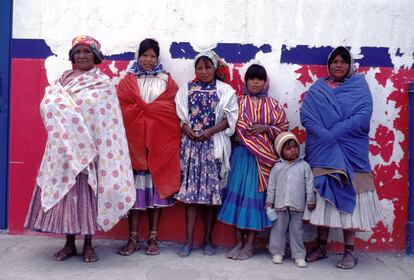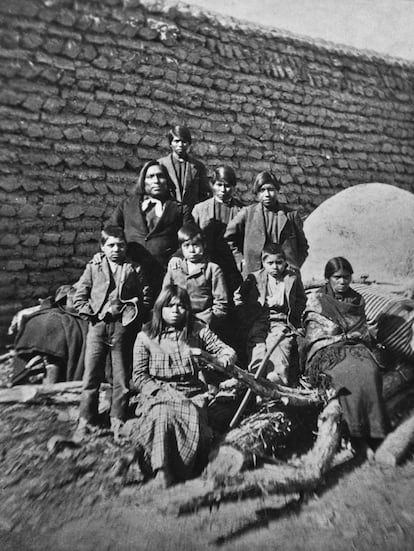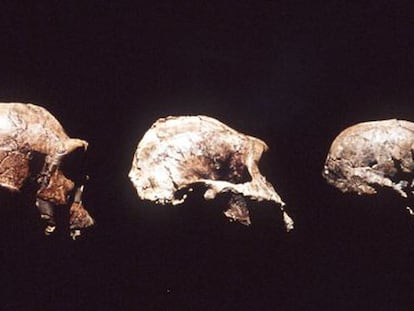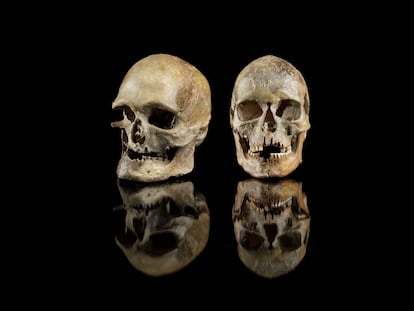The people of central Mexico resisted a dramatic change in climate 1,000 years ago
The ancient DNA of pre-Hispanic Mesoamerican populations reveals a genetic continuity that indicates their adaptation after centuries of mega-droughts

Before colonization, present-day Mexico was divided into Aridoamerica and Mesoamerica. Each region was home to people groups who specialized in different activities. In the first, the arid north, pre-Hispanic peoples were hunter-gatherers. In the second, the center and south of the country, larger civilizations were established, which survived thanks to agriculture. The border between them has been a topic of study for decades. Until now, the predominant idea, based on archaeological evidence, has been that the dividing line moved south because the groups living in Mesoamerica were forced to migrate by a dramatic change in climate, which occurred approximately a millennia ago.
However, a new study of the ancient DNA of these populations has revealed the same genetic features, before and after several centuries of mega-droughts. The discovery has opened up another option: some Mesoamerica people groups may not have been displaced, but rather adapted to new ways of life amidst the lack of water. That resistance and capacity for adaptation is notable alongside the political crisis in the Mayan civilization that later provoked large droughts, which previously had led to the collapse of ancient empires like the Hittites.
The genetic diversity of pre-Hispanic peoples shows continuity during the last 2,300 years, and it still survives in populations in Mexico today. Current indigenous groups in the country share DNA similarities with ancient inhabitants. That genetic correspondence is one of the conclusions of the study “Demographic History and Genetic Structure in Pre-Hispanic Central Mexico”, published today in Science, which sheds light on the demographic movements in ancient societies. A group of scientists has conducted the largest genetic study ever of peoples in ancient Mexico. The findings bring new information about Mexico’s past and present.
Anthropological studies had formulated the hypothesis that some populations in Mesoamerica had migrated due to climate changes. But 27 genetic samples from different pre-Hispanic people, taken from eight archaeological sites, suggest something else. The analysis of some remains in the Sierra Gorda, located in central Mexico and the northern border of Mesoamerica, suggests that the population in that place did not migrate during the droughts between 900 and 1,300 C.E. “The individuals from the Sierra Gorda before and after the drought shared more genetic material between themselves than with any other pre-Hispanic individual,” the researchers say in their article.
One of the study’s co-authors, María Ávila-Arcos, from the National Autonomous University of Mexico (UNAM), explains that despite the fact that the droughts may have affected other populations, it’s as not the case of the inhabitants of the Sierra Gorda, which remained in place. “In the place that we studied, the population replacement did not happen. The continuity was clear,” she says in a phone interview. The publication points out that a possible explanation for that continuity is that “the favorable climate conditions in the north of the Sierra Gorda had maintained more humidity than other arid places of the northern border of Mesoamerica.”
Another factor that the scientists believe could have helped the inhabitants of the Sierra Gorda survive, especially those who lived in the present-day archaeological sites of Ranas and Toluqilla, is that many of them were involved in the commerce of cinnabar, or cinnabarite, a mineral that was scared to pre-Hispanic cultures. “We propose the hypothesis that cinnabar commerce and the Sierra Gorda landscape allowed the peoples of Toluquilla and Ranas to survive, despite the lack of precipitation,” the document says. The researchers admit, however, that there are factors that suggest that they could have experienced a reduction in population due to climate change.

The analysis, by scientists from the UNAM alongside researchers from academic institutions in Sweden, Denmark, United States, Spain, Germany and Australia, explains how the migration patterns of ancient Mexican civilizations are much more complex than expected. They note, for example, that the DNA among Mesoamerica peoples was linked, and there was genetic flow between Mesoamerican and Aridoamerican populations. Another correlation they trace is the continuity between the Pericú, who lived in the Baja California peninsula and disappeared in the 18th century, and the Pima, or Akimel O’odham, people, who currently live between Arizona, Sonora and Chihuahua.
The researchers, who used already existing genetic databases, also discovered two phantom populations, societies that had not been mapped until now. One of those genetic contributions, which the scientists have named UpopA and which they estimate was a community that separated from Native Americans 24,700 years ago, has also been found in the genome of current populations in northern Mexico, as well as the Mixe people in the south of the country. The other phantom genes (UpopA2) were identified in the Raramuri community in the Sierra Tarahumara. These lineages raise questions about how these exchanges occurred. “There are more questions than answers. What it does show us is that the process of populating America was fairly complex,” Ávila-Arcos concludes.
Sign up for our weekly newsletter to get more English-language news coverage from EL PAÍS USA Edition
Tu suscripción se está usando en otro dispositivo
¿Quieres añadir otro usuario a tu suscripción?
Si continúas leyendo en este dispositivo, no se podrá leer en el otro.
FlechaTu suscripción se está usando en otro dispositivo y solo puedes acceder a EL PAÍS desde un dispositivo a la vez.
Si quieres compartir tu cuenta, cambia tu suscripción a la modalidad Premium, así podrás añadir otro usuario. Cada uno accederá con su propia cuenta de email, lo que os permitirá personalizar vuestra experiencia en EL PAÍS.
¿Tienes una suscripción de empresa? Accede aquí para contratar más cuentas.
En el caso de no saber quién está usando tu cuenta, te recomendamos cambiar tu contraseña aquí.
Si decides continuar compartiendo tu cuenta, este mensaje se mostrará en tu dispositivo y en el de la otra persona que está usando tu cuenta de forma indefinida, afectando a tu experiencia de lectura. Puedes consultar aquí los términos y condiciones de la suscripción digital.
More information
Archived In
Últimas noticias
Venezuela hardens its ‘revolutionary state’ project amid pressure from Trump
Sydney Sweeney, the actress praised by Trump: ‘Women are up against what society wants them to be’
The Bolsonaro surname: An advantage or liability in Brazil’s 2026 presidential elections?
Raúl Rocha, from jet-setting with Miss Universe to arms trafficking and fuel theft
Most viewed
- Reinhard Genzel, Nobel laureate in physics: ‘One-minute videos will never give you the truth’
- Pablo Escobar’s hippos: A serious environmental problem, 40 years on
- Charles Dubouloz, mountaineering star, retires at 36 with a farewell tour inspired by Walter Bonatti
- Why we lost the habit of sleeping in two segments and how that changed our sense of time
- The fall of a prolific science journal exposes the billion-dollar profits of scientific publishing











































